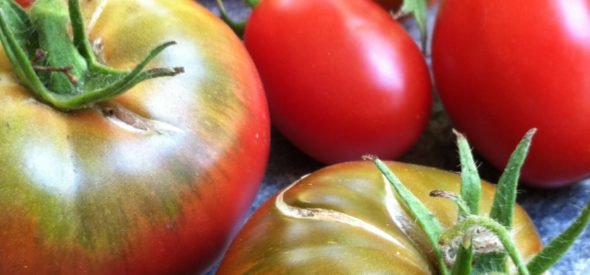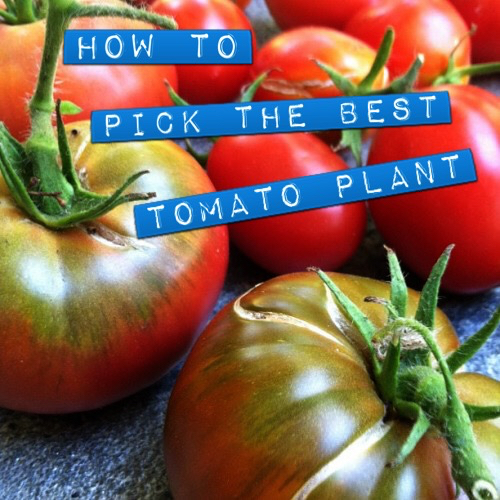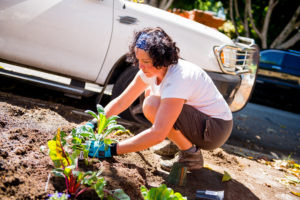How to Pick the Best Tomato Plant
1March 18, 2016 by Hope Gardens


Holy Lycopene, you guys. There are over 700 tomato cultivars available today. Overwhelming! Picking the healthiest plant is the most important choice of all. Here’s some tips while at the nursery.
- Buy a plant with a strong center stalk. Avoid the Charlie Brown plant. Avoid plants that are broken or split.
- Don’t buy a plant that is too tall and lanky. Don’t overlooks smaller plants. 6-9″ is a great size. If your favorite variety is a little on the lanky side you can always plant it deep when you get home.
- Buy a plant with just one seedling in the pot. This is not a good time for a two-for-one moment. Having two seedlings in a pot means those two plants have been sharing resources and that can lead to a weaker plant.
Separating plants is also not a great idea as you can permanently damage roots. Roots are a plant’s brains so keep that in mind when handling them. They don’t really want touched. - A container with roots coming out of the bottom you may want to pass on. Soil that pulls away from the container can mean a root-bound plant which you also want to leave behind.
- Buy a combination of indeterminate and determinate tomatoes. Indeterminate tomatoes grow over a long period of time. They tend to be viney and definitely need sturdy supports. They also benefit greatly from regular pruning. Determinate tomatoes are smaller, bushier plants that produce a larger crop over a shorter period of time. They don’t have to be staked as urgently and they don’t have to be pruned after you remove the bottom non-producing branches. So the argument is you get more tomatoes with less work.
- Buy a combination of early season, mid-season and late season tomatoes. Some tomatoes produce early, some late. That’s what all the days indicate on my Guide to Heirloom Tomato Recommendations. Here’s how the labels translate: Very Early: 54 days or less, Early: 55-69 days, Mid-Season: 70-84 days, Late Season: 85 or more. These numbers take you from germination to production. It’s nice to have something producing all summer long.
- Buy a disease-free tomato. No darkening or brown/black spots or streaks at the base of the plant where it meets the soil. No dark spots or white spots on the leaves.
- A hybrid (F1) tomato is not a GMO or GEO. Disease-resistant hybrids are a GOOD thing. Plants genetically engineered with weed killer are not the same as plants created over decades to be less susceptible to disease or have better flavor. Hybrids are not usually heirloom as hybrids cannot be “open-pollinated” meaning their seeds are sterile. So don’t avoid hybrids because you think they are on the same level as GMOs.
- Buy a tomato NOT on the Monsanto-trademarked seedling name list.
- Understand heirloom vs hybrid. If you are concerned about your plants being open-pollinated then you want to go with heirloom tomatoes. These plants are usually from a tomato variety from days gone by and are open-pollinated meaning you can collect the tomato seeds and replant them if you like.
- Don’t worry TOO much about organic. The most important part of the organic process is how YOU treat your plants once they are home. You don’t eat your tomato plant so you don’t need to worry too much.
- Pick plants that meet your needs. Want to eat fresh, can, puree, salsa or sauce? Want low-acid, tart or sweet? Green, yellow, pink, red, purple or brown? There’s a tomato for that.
- Get both cherry and slicing tomatoes. Beware of varieties that promise very large fruits. The longer a fruit grows on a vine the more susceptible it is to disease, bugs or a larger pest. Cherry or smaller tomatoes are far easier to grow. Just harvest them often. Fruits left on the vine may split, wither or if not harvested at all, stop producing.
PRO-TIPS for Tomato Growing
Once you get those tomatoes home, plant them promptly in a high-quality soil with compost if you have it. Add a high-phosphorous fertilizer to promote flowers and fruits and some bone meal to keep blossom-end rot away. As seen above, prune the bottom leaves and the lower 2-3 branches of the plant and then plant the tomato to the next leaf level. This may seem strange but this will give your tomato deep roots.
I encourage you to put a cage, ladder or stake on your tomato right away. Time flies when you’re having fun and wrangling an overgrown tomato plant can mean death…for the plant.
There are many theories on tomato growing.
A new/old idea for this summer is to try “dry-farming.” After your tomatoes are established and starting to produce, severely cut back on your watering. This will force the plants to fruit and not make large water-logged fruits. Instead, you will get smaller fruits with more concentrated flavor. This won’t work out well if you have plants other than tomatoes growing in the same area as they may need more water. Also won’t work great in containers as they dry out quickly.
You can heavily prune your plants to a single stem and plant them very close. OR you can not prune at all and let your leaves shade your plant from the extreme sun.
There is much much more on planting your tomatoes here and planting your spring garden here and all you need to know about summer garden maintenance here.
Category DIY Garden Guides, Vegetable gardening | Tags: Agriculture, Compost, edible garden, edible gardening, flower, fruit, Garden, Harvest, heirloom, Home, Home garden, hyrid, lettuce, Los Angeles, native, nature, organic, Plant, raised bed, raised bed garden, raised garden bed, Seed, Soil, Southern California, spring, Square foot gardening, summer, Tomato, Vegetable, Vegetable Garden


